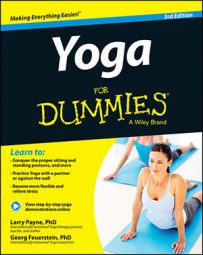If your body-mind is slow to wind down to get its well-deserved rest, here’s a potent technique to entice Mr. Sandman to visit you. Yogic Sleep is a powerful relaxation technique that you can do when you gain some control over the relaxation response. When practiced successfully, this technique can be as restorative as sleep — except that you remain fully aware throughout.
To induce Yoga Nidra, you must listen to a set of instructions, similar to guided meditation. You can listen to a friend reading the instructions, but listening to a recording by someone else or by you yourself is more practical.
One feature of this practice is to focus in relatively quick succession on individual parts of the body. Mentally name each part, and then sense it as distinctly as possible.
In the beginning, you may find actually feeling certain body parts difficult. Don’t let this setback dismay you; continue to rotate your awareness fairly swiftly. With practice, you can include in this circuit even your inner organs and all kinds of mental states.
Practicing Yoga Nidra before sleep is best because it’s an excellent technique for inducing lucid dreaming and out-of-body experiences during sleep. Lucid dreaming refers to the kind of dream in which you’re aware that you’re dreaming. Great Yoga masters remain aware even during deep sleep. Only the body and brain are fast asleep, whereas awareness is continuous.
The following steps show you how to perform Yoga Nidra.
Choose a clear intention, and lie flat on your back, with your arms stretched out by your sides (or however feels most comfortable).
Place a pillow or folded blanket behind your neck for support, and use another pillow or folded blanket under your knees for added comfort.
Close your eyes.
Repeat the clear intention you chose in Step 1 three times.
Take a couple deep breaths, emphasizing exhalation.
Starting with your right side, rotate your awareness through all parts on that side of your body — limb by limb — in fairly quick succession.
Follow this progression: each finger, palm of the hand, back of the hand, hand as a whole, forearm, elbow, upper arm, shoulder joint, shoulder, neck, each section of the face (forehead, eyes, nose, and so on), ear, scalp, throat, chest, side of the rib cage, shoulder blade, waist, stomach, lower abdomen, genitals, buttocks, whole spine, thigh, top and back of knee, shin, calf, ankle, top of foot, heel, sole, toes.
Be aware of your body as a whole.
Repeat the rotation in Step 5 on the left side, ending with the whole-body awareness described in Step 6.
Repeat Steps 5 through 7 one or more times until you achieve an adequate level of relaxation.
Continue to be aware of the whole body and the space surrounding it, feeling the stillness and peace.
Reaffirm your initial intention three times.
Mentally prepare to return to ordinary consciousness.
Gently move your fingers for a few moments, take a deep breath, and then open your eyes.
No time limit applies to your Yoga Nidra performance unless you impose one. Expect to come out of Yogic Sleep naturally, whether you return after only 15 minutes or a whole hour. Or you may just fall asleep. If you have things to do afterward, make sure you set your phone or meditation app for a gentle wake-up call. Don’t rush! Take your time to reintegrate with the ordinary world.
This is the most powerful yogic technique for personal change at the beginner level. Only the ecstatic state (samadhi) is more transformative. Several good recordings for practicing Yoga Nidra are available, but don’t be surprised to discover that the instructions vary from recording to recording.

